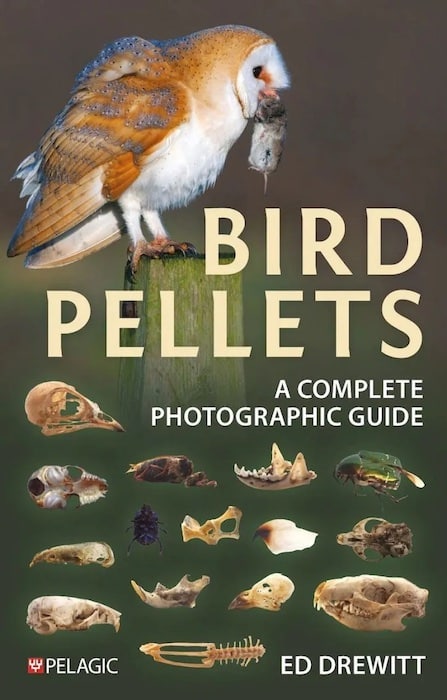| Bird Pellets – A Complete Photographic Guide | Ed Drewitt | Pelagic Publishing | 2024 | Paperback | 250 pages, 500+ colour photos | ISBN: 9781784274719 | £26.99 |

The Publisher’s View:
This book is the first comprehensive guide to bird pellets, the undigested remains of food that form together into a ball or sausage-like shape and are regurgitated. It showcases the range of pellets that different bird species produce, including owls, hawks, falcons, corvids such as ravens and magpies, as well as waders – and even garden birds! The common items found in them, such as small mammal skulls and bones, are analysed in detail, with the discussion accompanied by numerous colour illustrations.
The book progresses methodically from an introduction to pellets, covering what they are and how they are formed, to instructions on dissection and analysis and how this can be used in research, followed by a closer look at the pellets of each bird species in turn – from the golden eagle to the dipper. We learn how to identify the remains of small mammals including bats, as well as reptiles, amphibians, fish, invertebrates and of course other birds.
Dissecting bird pellets and identifying what is inside can be an important tool for discovering what birds are feeding on as part of more detailed diet studies. It is also an activity often delivered at family-friendly events or in schools by wildlife organisations. Extracting information from pellets also has sound scientific value: while it does not capture everything a bird has been eating, it still goes a long way in revealing the diet of birds and how this may change over time, in different habitats and different parts of the world.
The Author: Ed Drewitt is a professional naturalist, wildlife detective, and broadcaster for the BBC. He has been studying urban Peregrines for over 15 years, and specialises in colour ringing their chicks, and identifying what they have been eating.
Fatbirder View:
I’ve been a birder more than sixty years and had no idea that corvids and others regurgitated pellets like owls and other raptors. I’ve rarely come across pellets but the thing that springs to mind every time is “what bird did that’. The very question the book sets out to solve. It is extremely informative and would be a great teaching tool with its hundreds of illustrations helping to identify contents and, so, the consumer.
I love that chapter one tells you how to distinguish pellets from poo… a remarkably easy mistake to make!
Even given that some birds of prey are catholic in their tastes and that a bundle of fishbones could be the leftovers of a number of species there is a great deal here to help… especially when coupled with more ‘everyday’ fieldcraft such as when and where the pellet appears, for example.
Great addition to the birder’s shelf and the high school library.
Fatbirder
